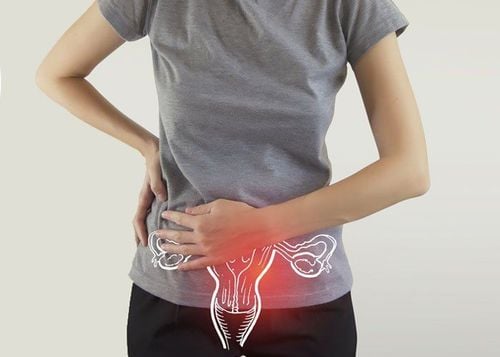This is an automatically translated article.
Genetic studies have demonstrated that monoclonal uterine tumors derived from uterine muscle stem cells have undergone specific molecular changes into proliferating tumor-initiating stem cells and subsequently differentiated under the influence of steroid hormones. There is increasing interest in the role of micronutrients, including vitamins, in the treatment of uterine fibroids. This article will analyze more about this content.1. Uterine fibroids
Uterine fibroids or fibroids, muscle tumors that can grow on your uterus. They rarely turn cancerous and if you have signs related to a tumor in your uterus, you are more likely to have uterine cancer.Fibroids can vary in size, shape, and location. The tumor may appear in the uterus, the wall of the uterus, or on its surface. Tumors can also attach to your uterus by a stalk or stem-like structure.
Some tumors are so small that your doctor cannot even see them with the naked eye. Some other tumors grow into large masses that can affect the size and shape of your uterus.
Uterine fibroids usually appear in women of childbearing age - between the ages of 30 and 40, but they can manifest at any age.
2. Causes of uterine fibroids
Experts don't know exactly why you get fibroids, and hormonal and genetic causes may make you more likely to get them.Hormonal. Estrogen and progesterone – hormones that cause the lining of the uterus to thicken every month during menstruation. They also seem to affect the growth of fibroids. As hormone production slows down during menopause, fibroids often shrink. Genetics. The researchers found genotype differences between fibroids and normal cells in the uterus. Other growth factors. Substances in the body that can help maintain organ tissues, such as insulin-like growth factor, may play a role in fibroid growth. Extracellular matrix (ECM). The extracellular matrix makes your cells stick together. Fibroids have more extracellular matrix than normal cells, which makes them fibrous. The extracellular matrix also holds growth factors in it and causes cells to change.
3. Risk factors
Several factors can increase the risk of developing fibroids, such as:Age Ethnicity Menstruation at a young age Using birth control Vitamin D deficiency Eating too much red meat and not enough green vegetables, fruit or milk Alcohol History You are more likely to have fibroids if your mother or sister has had fibroids.

Rượu là một trong những yếu tố nguy cơ gây phát triển u xơ tử cung
4. Diagnosis of uterine fibroids
Your doctor may suspect you have fibroids during a routine pelvic exam. If the shape of your uterus feels abnormal or unusually large, they may order further tests, such as:Ultrasound. Ultrasound uses sound waves to take pictures of the uterus. The technician will place an ultrasound device into your vagina or on your abdomen to take pictures. Your doctor can then see if you have fibroids and where and how big they are. Test. Your doctor may want you to have a blood test to find out why you have fibroids. Your complete blood count (CBC) can help them decide if you have anemia (low red blood cell count) or other bleeding disorders. Magnetic resonance imaging (MRI). If your doctor needs more information after you have an ultrasound, you can also have an MRI scan. Magnetic resonance imaging shows more detailed images of uterine fibroids and can help your doctor decide on the best treatment. Your doctor may also recommend an MRI if you have a large uterus or are close to menopause. Hysterosonography. In this test, a technician pushes saline into the uterine cavity and makes the uterus larger. This helps them see fibroids that are growing in your uterus (submucosal fibroids) and the lining of your uterus. This is useful if you are trying to get pregnant or have heavy periods. Ultrasound capture. To help check if your fallopian tubes are blocked, you can have an ultrasound of the uterus. Your doctor uses a dye to highlight your uterus and fallopian tubes on an X-ray to help see these areas better. Uterine endoscopy. Your doctor inserts a small telescope with a light attached to your cervix. Then, injecting saline and widening the uterine cavity, the doctor can look at the wall of your uterus and the opening of your fallopian tubes.
5. Treatment of uterine fibroids
The treatment that's best for you will depend on whether you're having symptoms, wanting to get pregnant, and the age and location of the fibroids.Watchful waiting If you have only mild symptoms - or no symptoms - your doctor may suggest that you wait. Fibroids are not cancerous and they grow slowly or not at all. Because, fibroids can also shrink or disappear after menopause.
Drugs Medicines for uterine fibroids will treat your symptoms. Fibroids will not go away but may shrink with certain medications. Medicines can also help relieve symptoms such as pain and bleeding.
Oral contraceptives can reduce bleeding and non-steroidal anti-inflammatory drugs such as ibuprofen or acetaminophen can help.
What vitamins should not be used for uterine fibroids? Vitamins A and D are of particular interest following studies of their effects on the treatment of uterine tumours, in addition, vitamin B3, vitamin C, and vitamin E have not been extensively studied. However, vitamins especially vitamin D and iron supplements can help provide energy if you have heavy bleeding and are anemic.

Có thể điều trị u xơ tử cung bằng thuốc hoặc phẫu thuật
Oriahnn, a combination of elagolix - a GnRH antagonist, estrogen, and progestin, the first FDA-approved non-surgical oral drug option for the control of heavy menstrual bleeding. Taking the pill can reduce bleeding by an average of 50%. Gonadotropin-releasing hormone (GnRH) agonists - a temporary state of menopause by blocking estrogen and progesterone. This can shrink your fibroids. A progestin-releasing intrauterine device (IUD) inserted into the uterus can help control heavy bleeding. It also helps prevent pregnancy.
tranexamic acid (Cyklokapron, Lysteda) - non-hormone drug. You take it on days when you're bleeding heavily to slow your flow.
Surgery If you have moderate or severe symptoms, you may need surgery to reduce the tumor. Options include:
Muscle excision. Remove fibroids while trying to leave healthy tissue. There are many ways to perform a lumpectomy, from major intra-abdominal surgery to laparoscopy. Endometrial ablation. Surgeons use lasers, or cryotherapy, to remove or destroy the lining of the uterus. You may have this minor surgery as an outpatient. Usually, you'll stop getting your period after that date and you won't be able to get pregnant again. In uterine fibroid embolization (UFE), or uterine artery embolization (UAE), doctors block the flow of blood to fibroids by inserting gels or plastic beads into nearby blood vessels. This causes the fibroids to shrink. Removal of the uterus. This surgery completely removes your uterus, the only way to completely cure fibroids. The surgery is large, but your doctor has options for how to do it, including transabdominal resection or even laparoscopic surgery.
6. Prevention of uterine fibroids
It's not possible to prevent fibroids, but there is some research that shows certain lifestyle habits can lower your chances. A diet high in sugar may lead to a higher risk of disease for some women. Using fresh fruits and cruciferous vegetables such as arugula, broccoli, cabbage, cauliflower, collard greens, and turnip greens can reduce rates. Cruciferous vegetables are rich in nutrients such as: Beta-carotene, folate, vitamins C, E, K and other minerals. The composition of these foods is also full of fiber. Using evening primrose oil for subjects at risk of uterine fibroids helps to balance hormones. As for soy, there needs to be more in-depth research to prove its role in supporting uterine fibroids.If you have a need for consultation and examination at Vinmec Hospitals under the national health system, please book an appointment on the website (vinmec.com) for service.
Please dial HOTLINE for more information or register for an appointment HERE. Download MyVinmec app to make appointments faster and to manage your bookings easily.
References: ncbi.nlm.nih.gov, webmd.com












